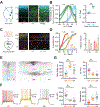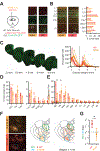Mediodorsal and Ventromedial Thalamus Engage Distinct L1 Circuits in the Prefrontal Cortex
- PMID: 33188733
- PMCID: PMC7855187
- DOI: 10.1016/j.neuron.2020.10.031
Mediodorsal and Ventromedial Thalamus Engage Distinct L1 Circuits in the Prefrontal Cortex
Abstract
Interactions between the thalamus and prefrontal cortex (PFC) play a critical role in cognitive function and arousal. Here, we use anatomical tracing, electrophysiology, optogenetics, and 2-photon Ca2+ imaging to determine how ventromedial (VM) and mediodorsal (MD) thalamus target specific cell types and subcellular compartments in layer 1 (L1) of mouse PFC. We find thalamic inputs make distinct connections in L1, where VM engages neuron-derived neurotrophic factor (NDNF+) cells in L1a and MD drives vasoactive intestinal peptide (VIP+) cells in L1b. These separate populations of L1 interneurons participate in different inhibitory networks in superficial layers by targeting either parvalbumin (PV+) or somatostatin (SOM+) interneurons. NDNF+ cells also inhibit the apical dendrites of L5 pyramidal tract (PT) cells to suppress action potential (AP)-evoked Ca2+ signals. Lastly, NDNF+ cells mediate a unique form of thalamus-evoked inhibition at PT cells, selectively blocking VM-evoked dendritic Ca2+ spikes. Together, our findings reveal how two thalamic nuclei differentially communicate with the PFC through distinct L1 micro-circuits.
Keywords: Ca2+ Signals; Circuits; Cortex; Dendrites; Inhibition; Interneurons; Layer 1; Prefrontal; Projection Neurons; Thalamus.
Copyright © 2020 Elsevier Inc. All rights reserved.
Conflict of interest statement
Declaration of Interests The authors declare no competing interests.
Figures








References
-
- Acsady L, Gorcs TJ, and Freund TF (1996). Different populations of vasoactive intestinal polypeptide-immunoreactive interneurons are specialized to control pyramidal cells or interneurons in the hippocampus. Neuroscience 73, 317–334. - PubMed
-
- Agmon A, and Connors BW (1991). Thalamocortical responses of mouse somatosensory (barrel) cortex in vitro. Neuroscience 41, 365–379. - PubMed
-
- Ährlund-Richter S, Xuan Y, Lunteren van JA, Kim H, Ortiz C, Dorocic IP, Meletis K, and Carlén M (2019). A whole-brain atlas of monosynaptic input targeting four different cell types in the medial prefrontal cortex of the mouse. Nat. Neurosci 22, 657–668. - PubMed
Publication types
MeSH terms
Grants and funding
LinkOut - more resources
Full Text Sources
Other Literature Sources
Molecular Biology Databases
Miscellaneous

